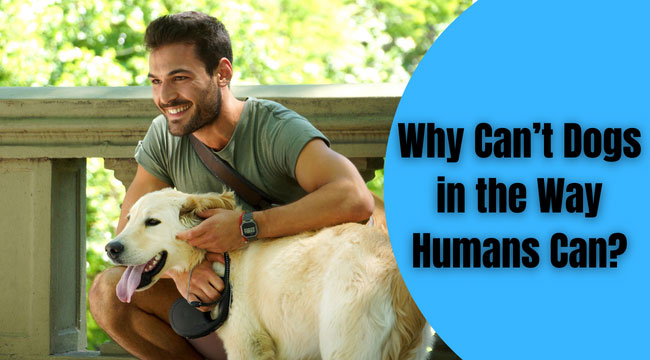
Dogs are said to be one of the smartest animals on Earth, and bagging the title “Man’s Best Friend” certainly means that they have established a strong bond with us, humans. Being domesticated and practically living amongst us, they have adopted a lot of our habits and behavior – they watch TV with us, play games, ask for rewards, and many more. However, one thing remains quite impossible for them – being able to talk like humans.

Dogs can’t talk like humans because their brains are not developed to perform such complicated tasks. Furthermore, their mouths are not equipped for talking the way human mouths are. However, dogs can understand simple words since their brain function is quite similar to a toddler’s.
We will talk about why dogs cannot speak like humans, particularly the factors that contribute to their inability to form words. We will also discuss how dogs communicate with us, especially since spoken words are not the only means of communication. Let’s get the ball rolling!
What Prevents Dogs From Talking Like Humans?
Dogs’ physical and cerebral limitations prevent them from talking like humans. Dogs can’t talk simply because they are not equipped to do so. Their brains are programmed differently. Their mouths are uniquely designed, and their tongues serve various other purposes.
For us humans, one of our most effective forms of communication is through spoken words. We do it almost effortlessly because each factor responsible for talking works hand in hand. We can talk because we have a brain, lungs, throat, voice box, tongue, and lips.
Dogs have these, too, but the canine counterparts of these body parts are not designed to allow them to speak.
Human Brain vs. Dog Brain
For over thousands of years, the human brain has evolved into a highly complex organ capable of running practically every human body part. Our brain can process multiple types of information all at once, which is why we can walk, run, think, and talk.
On the other hand, dogs’ brains aren’t as intricate and competent. In fact, studies have found that their brains have difficulty distinguishing between words that sound similar.
For instance, if you say “set” instead of “sit,” your dog will probably go ahead and plop down near your feet, expecting to be rewarded with a treat. This doesn’t necessarily mean that dogs can’t hear the differences in sounds, for example, between the letters I and E. They can distinguish it, but they lack the brain power to process it further.
So, your dog will sit, even if you say “set.” They will catch a ball, even if you say “watch.” They can hear the subtle difference in sound, but their brains do not know what to do with this information. So they just go ahead and stick to what is already familiar.
Human Mouth vs. Dog Mouth
Whenever we talk, our mouths do most of the hard work. Our lips move, our tongues flick, roll, or stretch, and our teeth help make particular sounds. On the other hand, dogs’ tongues and lips aren’t as flexible as ours, so they cannot produce sounds that make up words. Their mouths can only produce sounds that do not require complex movements.
For instance, try saying the words “popcorn,” “belly rub,” and “food” without moving your mouth, particularly your lips and tongue. It’s nearly impossible to comprehend. Dogs’ mouths are rigid and designed only for simple tasks like eating, licking, barking, growling, or whimpering.
Can Dogs Only Understand Simple Words?
Dogs can understand us on a level deeper than just simple words, and most dog owners will agree because dogs are surprisingly smart. They may not understand each word of every sentence we speak, but you can count on them to grasp the emotions and thoughts attached to these words.
Dogs are often more intelligent than we give them credit for. Notice that when you’re talking to your dog, they almost always give you their full attention.
They may not understand all of your words, but they can understand why your eyes look a certain way, why your hands are gesturing a particular way, and why your voice is louder or softer than usual. Dogs can sense and understand anger, sadness, frustration, fear, and happiness.
How Dogs Communicate
Dogs may not be able to talk, but they can express themselves well. They use facial expressions, sounds, and body language to get their messages across, according to a reliable source.
If you know your dog well, you won’t have a hard time understanding them because they can develop their own methods of communication.
For instance, a dog may make whimpering noises to convey hunger. Other dogs may run around in circles, looking like they’re trying to catch their tails to signal that they need to pee. Some may give you those notorious puppy dog eyes, and you’ll instantly know they’ve done something they’re not supposed to.
It takes a lot of patience and time to get to know your dog. If you spend enough time together, you’ll soon realize that you can almost read them like a book. Their body language will be dead giveaways of exactly how they feel.
Here are some examples of how dogs communicate with us:
- Wagging tail. This means that your dog is extremely happy and excited. They are pleased with what is currently going on or with whom they are spending time.
- Ears down, stiff body, bared teeth, and growling. This means that your dog is upset. There is something or someone in their immediate surroundings that they do not like.
- Tail lowered and tucked between the legs, trembling, pacing, or frozen in one spot. This means that your dog is scared of something or someone nearby. They may be asking you for help in getting them out of that difficult situation.
- Digging, scratching, barking for no reason. This could signal that your dog is bored. They may be looking for some form of entertainment, a little bit of playtime, or maybe they just want new toys to play with.
- Jumping up, running around wildly, barking, panting, and tail wagging. This means that your dog is extremely excited. They may be thrilled to see you, or they may feel very excited about something that is about to happen. Maybe they can sense that it’s time for their walk and can’t wait to get the ball rolling.
- The body is relaxed, eyes are half shut, and they look as if they have no care in the world. This means that your dog feels very secure and content with the current situation. They may be feeling satisfied after a particularly sumptuous meal, or maybe they’re just glad that you’re close by because you make them feel safe.
Final Thoughts
Your dog’s inability to talk does not mean that they aren’t smart. There are multiple other ways to determine an individual’s intelligence, and most dogs certainly fit into the smart category. Spend a lot of time with your dog so that you will learn how they effectively communicate their thoughts, emotions, and desires.
Sources
- https://www.livescience.com/dogs-word-processing.html
- https://dogfriendlyscene.co.uk/why-cant-dogs-talk-like-humans/
- https://doggysaurus.com/will-dogs-ever-be-able-to-talk/
- https://www.npr.org/2010/08/11/129083762/from-grunting-to-gabbing-why-humans-can-talk
- https://www.scientificamerican.com/article/fact-or-fiction-dogs-can-talk/#




